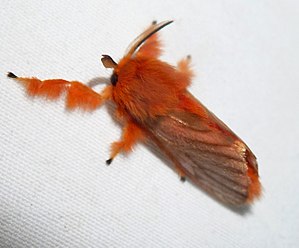Dalceridae
| Dalceridae | ||||||||||
|---|---|---|---|---|---|---|---|---|---|---|

|
||||||||||
| Systematics | ||||||||||
|
||||||||||
| Scientific name | ||||||||||
| Dalceridae | ||||||||||
| Dyar , 1898 |
The Dalceridae are a family of butterflies (Lepidoptera). Of these, 84 species are known from the Neotropic , only one of these species is also found in Arizona . The monophyly of the family is due to the close juxtaposition of the wing veins R1 to R2 and R3 to R4, the regression of different areas of the male genitals, the gelatinous appendages of the caterpillars and the presence of additional abdominal bones on the second and seventh abdominal segments of the last two caterpillar stages of some species justified. The relationship within the Zygaenoidea or possibly also the Cossoidoidea is still unclear. However, the family has some characteristics that establish a relationship with the Megalopygidae , Epipyropidae and the snail spiders (Limacodidae).
features
The moths are small to medium-sized and have a stocky and hairy body, which is usually white, yellow or orange in color. The head is small and also very hairy. Their wings are broadly rounded. In addition to the large compound eyes , the animals have no point eyes ( ocelli ). Their proboscis and maxillary palps have receded, the short labial palps are bipartite and directed upwards. Their antennae are short, long in the males and short pinnate in the females. The wing veins are well developed. The radial veins of the front wings run differently close to one another, depending on the type, only R1 and R2, like R3 and R4, are always adjacent or connected to one another.
The caterpillars resemble nudibranchs and have transparent, gelatinous, conical appendages on their backs. The thoracic legs are very small, the abdominal legs consist only of small lobes. In addition to the normal abdominal legs on the third to sixth abdomen segments, some species also have outer soles on the second and seventh abdomen segments during the last two caterpillar stages. The pusher is missing. The underside of the body, however, is primarily a slimy creep sole.
Way of life
The mostly nocturnal adults have difficulty flying and make staggering up and down movements in flight. You can rarely see them in the light. They cannot ingest food because of their stunted mouthparts. In the resting position, the wings are laid like a roof over the abdomen.
The caterpillars tend to crawl, although at least one species has some function of the belly legs. Pupation takes place in white or yellow, firm, oval cocoons between leaves. The web consists of an outer, loose part and an inner, dense part.
The females distribute their elongated and soft eggs, a maximum of one millimeter long, individually in the area. They are usually yellowish and coated with a fluid from glands from the abdomen that dries up quickly. A female usually lays several hundred eggs. A total of about 20 plant families are known as fodder plants. Deciduous trees and shrubs with delicate leaves are preferred, but the diet is polyphagous . Some species can cause damage to coffee , cocoa or palm trees in agriculture .
swell
Individual evidence
- ↑ a b c d e f Malcolm J. Scoble: The Lepidoptera: Form, Function and Diversity . Oxford University Press, Oxford 1995, ISBN 0-19-854952-0 , pp. 269 f . (English).
- ↑ a b c d Niels P. Kristensen: Lepidoptera, moths and butterflies . In: Maximilian Fischer (Ed.): Handbook of Zoology . 1st edition. tape 4 - Arthropoda: Insecta , volume 35. de Gruyter, Berlin / New York 1998, ISBN 3-11-015704-7 , p. 168 f . (English).